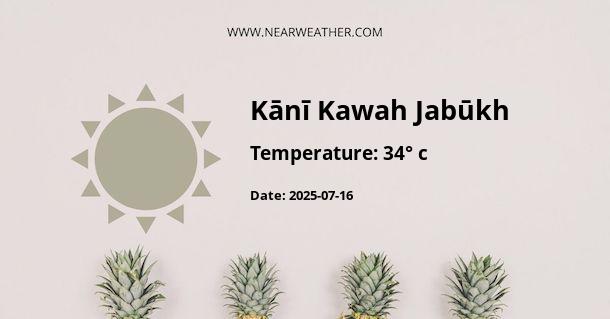Overview of Kānī Kawah Jabūkh, IQ
Kānī Kawah Jabūkh, situated in the Kurdistan region of Iraq, is a locale known for its diverse and variable weather patterns. This region experiences a semi-arid climate with a unique blend of weather conditions. Understanding the climate and weather in Kānī Kawah Jabūkh is important for those who reside there, as well as for individuals planning to visit or conduct business in the area.
Climate in Kānī Kawah Jabūkh
In Kānī Kawah Jabūkh, a semi-arid climate prevails. This climatic condition is characterized by hot, dry summers and mild, somewhat wet winters. The temperature fluctuates significantly throughout the year, with the warmest months being July and August and the coldest months being January and February. The region's average annual temperature is approximately 18.9 °C.
The semi-arid climate of Kānī Kawah Jabūkh is marked by a stark contrast between summer and winter temperatures, with a noticeable variation in precipitation levels throughout the year.
Year-Round Weather in Kānī Kawah Jabūkh
Kānī Kawah Jabūkh sees a wide range of weather conditions year-round, largely due to its semi-arid climate and geographical location. The weather is often unpredictable, with sudden shifts in temperature and unexpected rainfall. Here, we delve into the specific weather conditions experienced throughout the year.
Spring (March - May)
Spring is characterized by gradually rising temperatures, with an average high ranging from 16.5°C in March to 29.4°C in May. Precipitation during this period is relatively low with an average of 68.5mm in March, gradually decreasing to an average of 29mm in May.
Summer (June - August)
Summer in Kānī Kawah Jabūkh is typically hot and dry, with the average high temperatures peaking at around 38.9°C in July. The region sees minimal rainfall during these months, with June having the lowest average precipitation of the year at approximately 1.2mm.
Autumn (September - November)
Autumn sees a gradual decrease in temperature, with the average high ranging from 33.6°C in September to 20.1°C in November. The precipitation level begins to rise again, averaging around 23mm in September and reaching 70.2mm in November.
Winter (December - February)
Winter is relatively mild, with the average high temperature ranging from 12.2°C in January to 14.8°C in February. Precipitation peaks during this season, with average rainfall reaching up to 120.8mm in January.
Conclusion
Understanding the climate and weather patterns in Kānī Kawah Jabūkh is essential for planning activities and preparing for potential weather-related issues. The semi-arid climate, marked by hot, dry summers and mild, wet winters, shapes the region's unique weather patterns. While the weather can be unpredictable, being aware of the general trends can help in planning and preparation.
Whether you're a resident, a business owner, or a visitor, being aware of the climate and weather in Kānī Kawah Jabūkh can ensure you're prepared for what each season has to offer.
Despite the occasional unpredictability, the diverse weather patterns and unique climatic conditions make Kānī Kawah Jabūkh a fascinating region in the Kurdistan region of Iraq.
A - Kānī Kawah Jabūkh's Latitude is 35.310280 & Longitude is 45.726665.
A - Weather in Kānī Kawah Jabūkh is 7° today.
A - Climate Conditions in Kānī Kawah Jabūkh shows clear sky today.
A - Humidity in Kānī Kawah Jabūkh is 39% today.
A - Wind speed in Kānī Kawah Jabūkh is 4.72 km/h, flowing at 7° wind direction. today.
